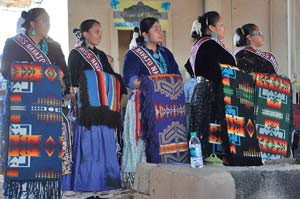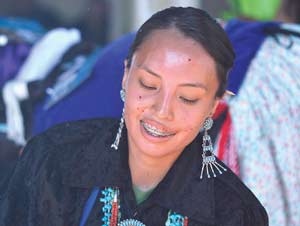'They pretty much know how to butcher'
Miss Navajo contestants impress judges, onlookers
By Alastair Lee Bitsóí
Navajo Times
WINDOW ROCK, September 05, 2013




(Times photo – Donovan Quintero)
TOP: Miss Navajo Nation contestants Wallita Begay left, and Darian Renae Isaac discuss their next move Wednesday during the Miss Navajo sheep butchering and bread-making competition at the Hazal Yazza Frybread Pavilion in Window Rock.
SECOND FROM TOP: Miss Navajo contestants from left, Lailuani Moore, Brittany Hunt, Wallita Begay, Joni Pino, and Versheena Toria Dempsey, wait to introduce themselves during the sheep butchering and bread-making competition Wednesday morning in Window Rock.
THIRD FROM TOP: Miss Navajo contestant Natasha Hardy wastes no time peeling the skin off the sheep on Wednesday morning during the Miss Navajo sheep butchering and bread-making competition at the Hazel Yazza Frybread Pavilion in Window Rock.
W
hen Miss Navajo Nation hopeful Natasha Hardy used her knuckles and strength to detach the skin in a "fisting maneuver" from the sheep's carcass, the hundreds of Navajo people in attendance during the 61st Miss Navajo Nation Butchering and Traditional Bread-making Competition affirmed her technique with cheers.
Hardy, who ran for Miss Navajo two years ago, was partnered with Brittany Hunt, of Shonto, Ariz, during the first day of the 2013-2014 Miss Navajo Nation Pageant, held at the Hazel Yazza Pavilion on the tribal fairgrounds. Hunt got an honorable mention in last year's competition against reigning Miss Navajo Leandra Thomas.
The pair of sheep-butchering veterans, easily won the one-hour-timed butchering contest. They finished about 15 minutes before the team of Wallita Begay and Darian Isaac finished second, and waited another 10 minutes before the the team of Joni Pino and Cherish Tso completed their butchering task just 10 minutes shy of the one-hour time limit.
Pageant-goer Minnie Davis, of Kit'siili, Ariz., was impressed with the butchering team of Hardy and Hunt. Hunt was able to redeem herself after fainting and being hauled away in an ambulance during last year's competition.
"They were quicker at taking the sheep apart except for the last part," observed Davis.
The last part Davis referred to is the struggle Hardy and Hunt had with cutting the backbone away from the sheep's carcass. Hardy had to used a hatchet to successfully detach it.
For the most part, the elderly woman said the women followed the proper steps in harvesting a sheep.
"They pretty much know how to butcher," she said.
The other team of Miss Navajo hopefuls consisted of Versheena Dempsey and Lailauni Moore, who finished third in the timed event.
Mistress of Ceremonies Jannalee Atcitty, Miss Navajo 2004-2005, applauded the hopefuls for butchering their sheep within the time allocated to them. It was the first time all contestants completed the sheep butchering during the one-hour time frame.
"Yeego, clap for them," she told the crowd, who responded with louder applause.
The four sheep were donated by the Begody and Thomas families, Jay Begay, owner of a Navajo churro sheep farm in Rocky Ridge, Ariz., and Oops-A-Daisy Flowers in Window Rock.
Before the butchering contest occurs, a crucial part of the entire process is to build a fire for the bread.
While Hardy and Hunt rested and waited for the bread-making competition to begin, the crowd became involved by encouraging Pino and Tso to take their turn at detaching the backbone of their sheep carcass.
"Come on, Joni!" shouted a family member of Pino's.
"You can do it!" said another.
During the bread-making competition, all eight women sat on their knees attending to the fire they built while kneading the dough needed to make fry bread and tortillas.
They were in plain view of pageant-goer Sue Bizade of Black Mesa, Ariz., who was taking photos of the contest. She noticed Moore's technique of making bread.
"She makes good tortillas," Bizade observed, as Moore flipped and thinned out the dough with her hands.
Hunt was well organized when making her bread, as she was the first one to take a seat while the rest of her counterparts continued making theirs. Tso was the last contestant to be judged of her bread-making skills.
Following the bread-making competition, the contestants turned their focus to the impromptu questions, which basically tested their knowledge about butchering and bread-making.
The impromptu questions were asked in Navajo, with the expectation of these eight Navajo women to answer each question in Navajo.
Thomas, who won the Best Butcher Award last year en route to becoming Miss Navajo, made it clear to the contestants, while speaking in the Navajo language about the instructions of this competition, to "speak in Navajo."
Some of the questions asked of the contestants were, "Wool is used to make rugs, what are some of the names of tools that are used for weaving?" "After the head is detached, what's the last thing you do before hanging up the sheep?" "How is the backbone taken apart?" "Name the different kinds of bread, and which is the healthiest?" "About what age should a person start learning to make bread?"
In an interview following the contest, Thomas told the Navajo Times the questions in the impromptu category of the competition were crafted to "another level" about history, instead of the typical yes-or-no questions or asking a contestant to explain the process of a particular subject.
"It was based on what they know," she said. "There was no right or wrong answer."
The way the questions were asked by the five judges not only confused the eight contestants but a few even confused the crowd, and they weren't shy about expressing their confusion.
"What?"
"Huh?"
"The question is not clear."
"She confused her," were some of the statements coming from the pavilion stands.
One of those confused bystanders was Lene Harvey of Chinle.
"I think the judges need to ask the questions correctly," she said, adding that only one judge should ask questions. "I think that's where the mistake is."
Hunt was probably the only contestant to answer her questions - all in Navajo - with very little problem.
She drew the questions, "About what age should a person start learning to make bread?" and "How do you use sheep fat in a ceremonial purpose?"
Through the interpretation of Bizade, who was sitting by this reporter, Hunt successfully answered both questions in Navajo with these answers, "As a young lady, I was taught at an early age to cook for my family, my brothers and sisters. So, the proper age of being able to cook for one's family begins when taught at an early age," and "In the Enemy Way Ceremony, sheep fat is mixed with ash for the blackening of the patient."
Miss Indian World Kansas Begay, who was among a slew of royalty at the contest, applauded the contestants for their hard work and skills.
"They were all really good," she said. "It takes a lot of strength to do it and that comes from their family."
Day Two of the 61st Miss Navajo Nation Pageant will continue today (Thursday) with a Navajo Interview Panel at 9 a.m., followed by the traditional talent and skill competition later in the day at 1:30 p.m.
Friday morning at 9 p.m. will be the contemporary talent and skills competition, followed by the evening gown competition at 6 p.m.
All the remaining Miss Navajo events will occur at the white tent at Navajo Arts and Crafts Enterprise in Window Rock.
The coronation of the 61st Miss Navajo will be on Saturday at 6 p.m.
Contact Alastair L. Bitsóí at 928-871-1141 or email abitsoi@navajotimes.com.

